Ritual and social functions of Gokokuji in the early Edo period
By Dong Jiacheng
Abstract
This paper is going to study Gokokuji Temple’s ritual and social functions in the early Edo period (1603‒868). First, I am going to discuss the foundation and rapid rise of Gokokuji in late seventeenth century due to generous subsidization by Keishō-in (1627‒1705), an eminent Tokugawa woman in the Ōoku, as well as her son Tokugawa Tsunayoshi (1646‒1709), the fifth shogun. Then I am going to focus on the transition of Gokokuji’s function and its relationship with the Tokugawa family in early eighteenth century, following the death of Keishō-in and Tsunayoshi. Based on the historical facts, I am going to argue that the transition of Gokokuji’s function was part of the result of the shogunate’s reform, which was carried out swiftly after Tsunayoshi’s death, in order to bring itself out of administrative inefficiency and financial crisis.
Keywords: Edo, Buddhist Temple, Tokugawa Shogunate, Genroku Period
Introduction: Why Gokokuji Temple?
Before analyzing the association between Gokokuji and the Tokugawa shogunate, there is one premised question to be answered: Why Gokokuji is an ideal example to demonstrate the power transition of the Tokugawa shogunate? There were many temples in Edo which have specific connection with the Tokugawa shogunate publicly, or with the Tokugawa family privately. This part of the project will introduce several of these temples according to their connection to the Tokugawa, and then demonstrate the uniqueness of Gokokuji among them.
Among the temples with the Tokugawa family’s patronage, Zōjōji was one of the most renowned ones for its association with the Tokugawa family since it accommodated the shogun’ mausoleum. Since the second shogun Tokugawa Hidetada’s (1579‒1632) funeral was held in Zōjōji, it has established permanent tie with the Tokugawa family as well as the shogunate for becoming the ancestral temple (bodaiji) of the shogun. As the shogun’s mausoleum, Zōjōji received regular subsidization from the shogunate for covering maintenance expense of the shogun’s grave. During the shogun’s funeral, all daimyo were obliged to donate “incense fee” (kōdenryō), which became an immense amount of fortune received by the temple.[1] Furthermore, the shogun would pay annual visit to the mausoleum for demonstrating their filial piety toward the ancestors, which all daimyo were again obliged to accompany, and to make their generous donations to the temple during the ceremony.[2] In summary, serving as the mausoleum of the shogun has brought Zōjōji a permanent association with the Tokugawa shogunate, which naturally brought immense economic benefit.

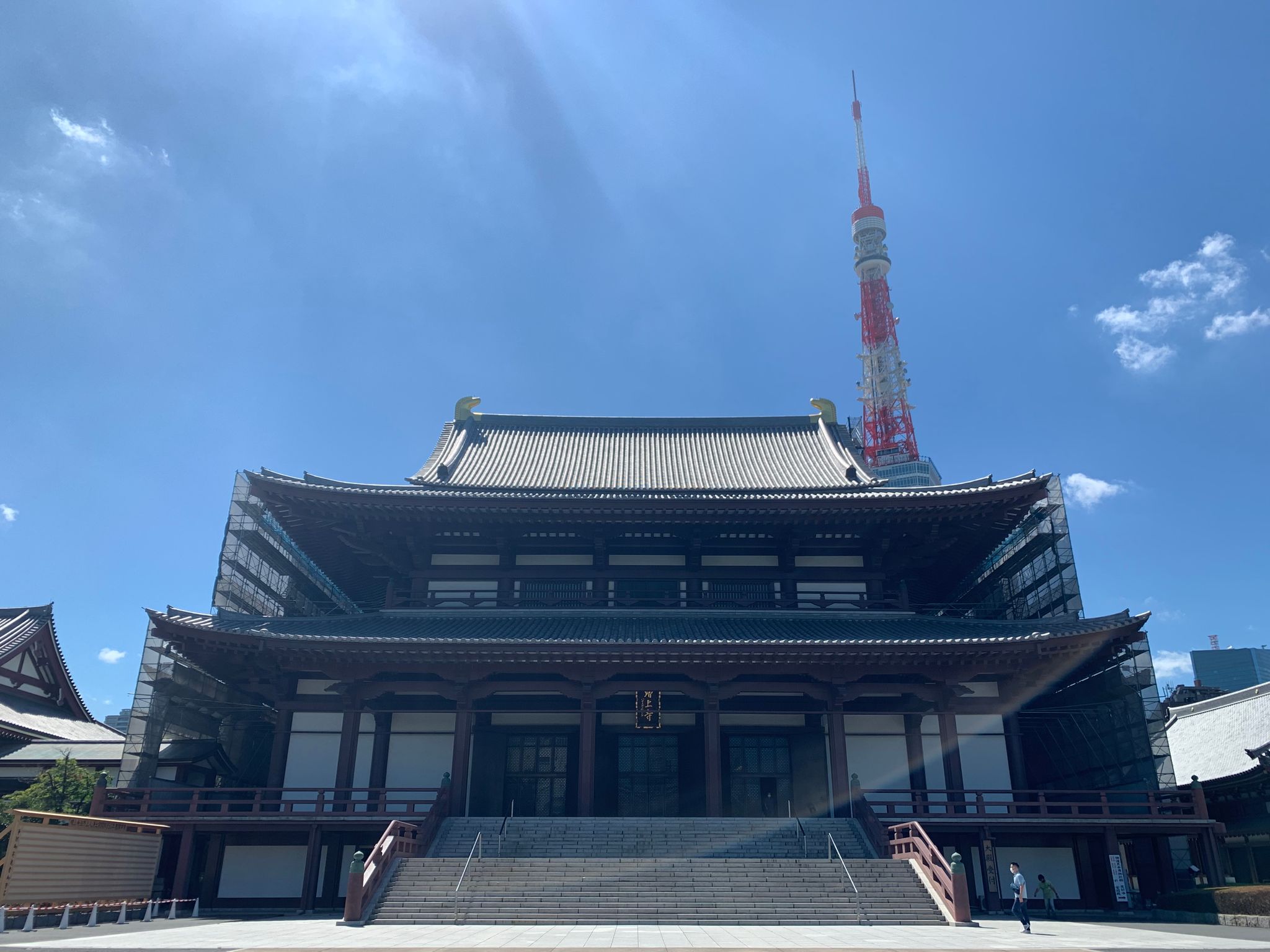
Nonetheless, Zōjōji was by no means free from facing competitor in such profitable business, which Kan’eiji was another temple renowned for its service as the shogun’s mausoleum. Established in Kan’ei 2 (1625) under ordain of the third shogun Tokugawa Iemitsu (1604‒1651), Kan’eiji located at the Northeast of Edo, as it was originally built for protecting the “ghost gate” (imon) of the Edo Castle.[3] After Iemitsu was buried in the realm of Kan’eiji, it has become the second designated temple for holding funeral and ancestral ceremonies for the shogun, which its status raised abreast with Zōjōji. After a few decades of competition, the rule was generally set that the two temples would both be the ancestral temple of the Tokugawa family, which the shogun’s funeral would be held alternately between Kan’eiji and Zōjōji. The two temples retained supremacy over the rest three of Tokugawa’s temples for their direct and permanent association with the Tokugawa house through serving as mausoleums as well as religious institutions for preforming the shoguns’ ancestral ceremonies.

Another example is Denzūin, a Jōdō sect temple established by Tokugawa Ieyasu (1543‒1616) to commemorate his birth mother Odai no kata (1528‒1602). After Odai passed away at the Fushimi Castle in Keichō 7 (1602), Ieyasu was originally planning to bury her in Zōjōji.[4] However, the abbot of Zōjōji, Kanchi, made an alternative suggestion to establish a new temple in Koishigawa as the mausoleum of Odai. He also suggested to build the new temple upon the basis of the thatched little temple owned by Shōgei, a renowned Buddhist master who was the mentor of Shōso, the founding master of Zōjōji, in order to commemorate his endeavor and contribution in studying Buddhist sutras.[5] Ieyasu followed this suggestion and ordered to construct a new temple in Koishigawa, for which its name, Denzūin, was directly borrowed from Odai’s Buddhist name during her late years. After the temple was finished, it served as the ancestral temple of the Tokugawa family along with Kan’eiji and Zōjōji. The only difference was that instead of commemorating shogun, only family members of the Tokugawa house were buried at Denzūin, which was the reason why it was much less eminent than the other two temples. Nonetheless, the private tie between the Tokugawa family and Denzūin has been preserved throughout the period. Besides Odai, several other important members of the Tokugawa house have also been buried at Denzuin, including Honri-in (1602‒1674), Iemitsu’s wife, and Tenju-in (1597‒1666), Hidetada’s daughter and once wife of Toyotomi Hideyori (1593‒1615).[6]

The third example is the Tōshōgu, the Shinto shrine which enshrined Tokugawa Ieyasu as the Great Tōshō Deity (Tōshō Daigongen). Although the belief of Tōshō Deity was officially a type of kami worship, it was, in fact, also associated with Buddhist believes under the Ryōbu Shinto system, especially because Ieyasu himself was a devout convert of the Tendai School Buddhism during his life time.[7] The story about Ieyasu’s birth, for example, has indicated that he was blessed by the power of Buddha since the beginning of his life. In the Origination of the Great Tōshō Deity (Tōshō Daigongen engi), a fictional legend with illustration created in order to legitimize Ieyasu’s dignification, Odai, Ieyasu’s birth mother, went for a pilgrimage at Hōraiji to pray to the Healing King (Yakushi Nyōrai) for giving birth to a male heir.[8] After returning from the pilgrimage, Odai had a dream in which she was “visited by a spirit,” who turned out to be Yakushi Nyōrai, to inform her that she was going to give birth to a male heir who is blessed by Buddhist power.[9] She became pregnant the next day, and eventually gave birth to a healthy boy who was later known as Tokugawa Ieyasu.[10]
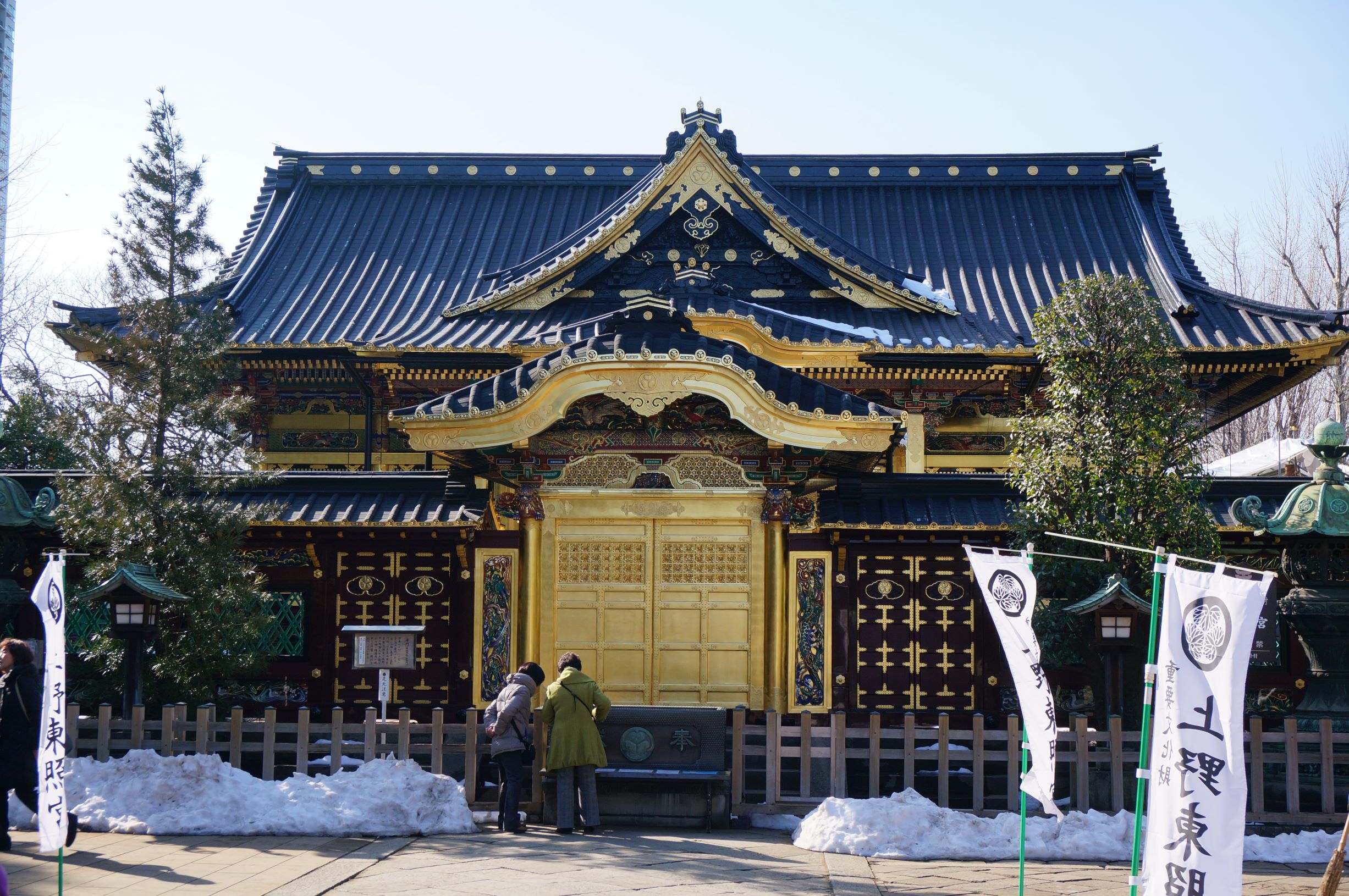
Besides creating the legend of Tokugawa Ieyasu, the shogunate also devoted immense wealth into promulgating the belief of Tōshō Deity through constructing Tōshōgu throughout Japan. The first, and probably the most imposing Tōshōgu was built in Nikko in Genna 3 (1617), followed by the second one constructed within the Edo Castle in 1618.[11] The shogun, as well as the shogun’s heir were obliged to pay regular visits to the Tōshōgu in Edo, accompanied by daimyo residing in Edo.[12] Besides the ones founded directly by the Tokugawa family, the shogunate also compelled daimyo to build Tōshōgu within their domain as a sign of compliance toward the Tokugawa’s authority.[13] Embodying the authority of the Tokugawa’s authority, the tie between Tōshōgu and the shogunate remained significant until the end of the Edo period.
Last but not least, the history of Gokokuji represents a very different story from the temples and shrine introduced above. It was founded in Tenna 1 (1681) based on the wish of Keishō-in (1627‒1705), birth mother of the fifth shogun Tokugawa Tsunayoshi (1646‒1709), to pray for her son’s health and fortune.[14] Due to personal connection with Keishō-in and the shogun Tsunayoshi, Gokokuji raised into one of the most permanent temples in Edo within less than two decades with temple’s territory (jiryō) valuing 1,200 koku in sum.[15] However, Keishō-in and Tsunayoshi died subsequently in Hōei 2 and 6 (1705 and 1709), and neither of their funeral was held in Gokokuji, which signified the end of its personal connection with the Tokugawa family. As a result, the association between the shogunate and Gokokuji declined rapidly into minimum within approximately a decade.[16]

Therefore, Gokokuji’s situation was different from other temples and shrines in Edo with its personal ties to Keishō-in and Tsunayoshi and was not related to either the legitimacy of the shogunate or the ancestral ceremony of the Tokugawa family. The next sections introduce how interactions between Gokokuji and the shogunate had been taking place during the lifetime of Keishō-in and Tsunayoshi, and what changes were brought upon Gokokuji after the death of the two figures.
Gokokuji’s Interaction with the Shogunate During the Reign of Tsunayoshi
During the reign of Tsunayoshi (1680‒1709), the interactions between the Tokugawa shogunate and Gokokuji were consistently active since the foundation of the latter in 1681. Nonetheless, most of figures who played active roles in such interactions belonged to a small community centering around the shogun Tsunayoshi and his birth mother Keishō-in. The studies on such interactions would be chiefly based on the dairy of Gokokuji (Gokokuji nikki), a primary source which contains detailed records about administrative and religious affairs taking place in Gokokuji on a daily basis. The published version covers documents dating from Genroku 10 (1697) to Hōei 6 (1709), the period which Gokokuji was mostly activated in performing various ceremonies and duties.[18] Based on studies on the primary texts, this section is going to categorize the interaction between Gokokuji and the shogunate into four general categories, which are 1) praying and presenting amulets (ofuda) for the shogunate, 2) receiving Keishō-in and Tsunayoshi’s pilgrimages to the temple, 3) presenting and exchanging gifts with the shogunate, and 4) abbot visiting the Edo Castle to attend various of duties and ceremonies.
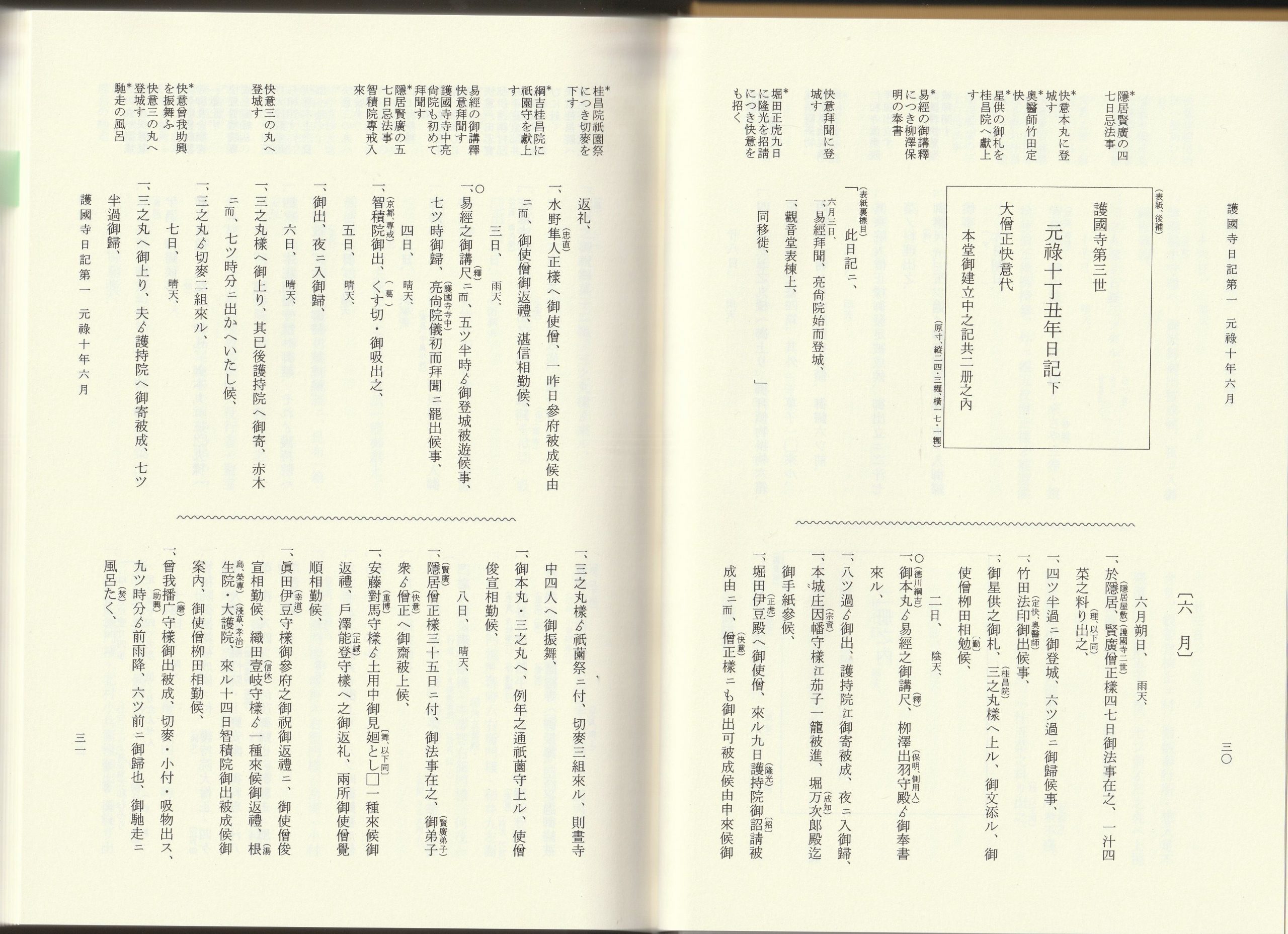
The function of Gokokuji as the praying temple (kodō-ji) of the shogun was officially affirmed in Genroku 5 (1692), as the temple was ordained to present amulets to the shogun at a monthly-basis.[20] Nonetheless, before officially becoming the praying temple, Gokokuji has been presenting prayers and amulets according to the request of powerful figures in the shogunate as one of its essential duties. Some examples extracted from the Diary of Gokokuji were:
Genroku 10.1.12: Amulets has been presented to Lady Tsuru by emissary monk Giten.[21]
Genroku 11.10.12: [The temple] was ordered at night to perform the Seven-Seat Ritual with the method of Monjū and Fudō, in order to pray for Chiyo-hime’s [Tokugawa Mitsutomo’s wife, Iemitsu’s daughter] recovery from illness.[22]
Genroku 14.1.14: Amulets have been delivered to Lord Ōkubo, daimyo of Kaga, who has ordered them in order to present them to His Excellency [Tsunayoshi].[23]
Genroku 15.7.1: An eclipse occurred this morning during 5-7 a.m., the ritual of Eight-Character Monjū was performed at the Five Altar until the sun was recuperated. After the ritual was finished, amulet was also sent to Lady of the Honmaru [Takatsukasa Nobuko, Tsunayoshi’s wife] with words attached.[24]
From looking at these examples, it is easy to understand that Gokokuji was obliged to perform various duties in praying for the shogunate, including presenting amulets regularly to important figures in the Edo Castle, as well as performing rituals under exigent situation like eclipse. Besides, Gokokuji also received orders from powerful figure like the senior councilor (rōjū) to produce amulets on his behalf, so he can present them to the shogun as a sign of demonstrating his compliance and concerns toward Tsunayoshi. Gokokuji has not only fulfilled the religious necessity of the shogunate, but also played an indispensable role in the secular relationship between the shogun and his bureaucrats.

The second duty of Gokokuji was to receive Keishō-in and Tsunayoshi’s pilgrimages. The first official trip to Gokokuji was done of Keishō-in in Tenna 3 (1683), one year after the foundation of the temple.[26] Since then, pilgrimages to Gokokuji had become routines for both Keishō-in and Tsunayoshi, which would take place multiple times annually before Tsunayoshi’s death. The visits of Keishō-in and Tsunayoshi to Gokokuji usually followed a similar procedure, which one of the typical examples is as following:
[Genroku 12].4.1. Cloudy, small rain between 5-7 p.m.,
His Excellency [Tsunayoshi] and the Lady of Sannomaru [Keishō-in] has visited our temple today.
The Lady of Sannomaru…has arrived at our temple after nine o’clock… After having a meal, she visited the teahouse at Takayama [within Gokokuji] and went for sightseeing with people around her. After appreciating paintings and enjoying buckwheat noodles, she returned to the palace [built for welcoming her and Tsunayoshi’s visit].
His Excellency arrived between 9-11 a.m.…He entered a discussion with former abbot of Gojiin [Ryūkō] and Eigaku, and bishop of the Hasedera Temple…regarding the matter of Gengyō Jido…and a little bit on the Analects. Later, he enjoyed shimai [noh dancing without putting on costume and mask—added by author] …Makino Yasushige [(1677-1723), daimyo of Komoro domain], and Kuroda Naokuni [(1667-1735), Tsunayoshi’s attendant (koshō)] were asked to performing dancing…
His Excellency has left before 2 p.m.
The Lady of Sannomaru has left after 4 p.m.[27]
From observing the example, it is not hard to notice that although their trip to Gokokuji was nominally a “pilgrimage,” Tsunayoshi and Keishō-in did not forget to treat themselves with a fine dinner, a tea ceremony, shimai, and other sorts of entertainment. According to the Gokokuji-shi, the pilgrimage to Gokokuji was also an opportunity for Keishō-in and Tsunayoshi to spend some time with each other as mother and son, which otherwise would be hardly possible for them to do so as the shogun and the head of the Ōoku.[28] In summary, for Keishō-in and Tsunayoshi, the pilgrimage to Gokokuji meant not only a chance for recreation and leisure, but also a precious time for them to spend together privately.
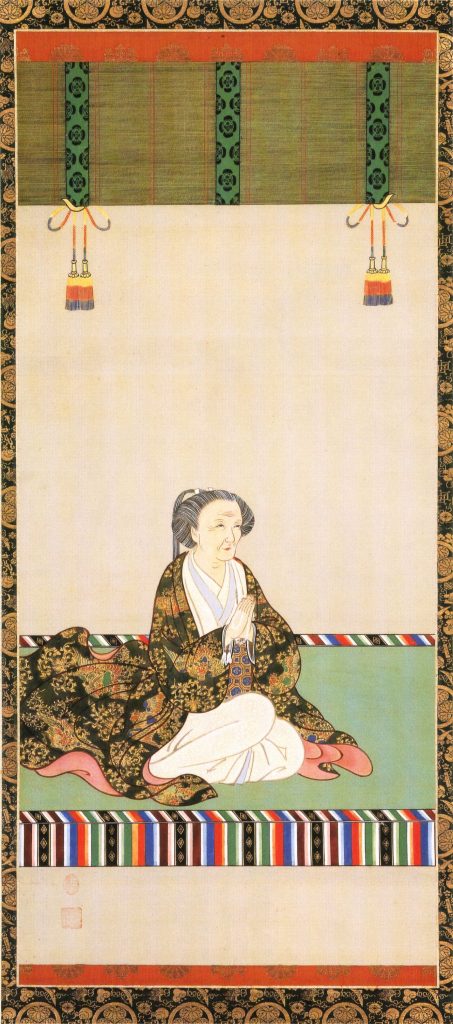
The third interaction was the exchange of gifts between Gokokuji and the shogunate. A few important figures of the Edo Castle were involved in exchanging gifts with Gokokuji as an annual activity. Nonetheless, Keishō-in was the most active participant among them, offering enormous gifts and budgets to Gokokuji according to seasons, events and rituals to be performed. Using the year Genroku 16 (1704) as an example:
Genroku 16.2.4: One basket of dandelions and one box of vegetable have been presented to Keishō-in. [29]
6.19: Matsudaira Terusada [(1665-1747), shogunate’s attendant (sobayōnin)], deputizing His Excellency, has offered a basket of ripe melon [as a gift] for consoling [the abbot of Gokokuji] amidst the hot summer.[30]
7.18: The Lady of Ichii [Keishō-in] has offered a basket of pear and a box of apple attached with words [as a gift to Gokokuji][31]
8.8: One basket of eggplant which was personally planted [by abbot of Gokokuji] has been presented to the Lady of Ichii [as a gift][32]
These examples indicated that gifts such as vegetables and fruits were frequently exchanged between the Edo Castle and Gokokuji according to different seasons in a year. Besides seasons, another significant situation for gift-exchange was during Keishōin and Tsunayoshi’s pilgrimage:
[During Keishōin and Tsunayoshi’s visit to Gokokuji on 3.10]
Gifts presented
To His Excellency,
One box of konbu, one box of shimai fans, one set of boxes made of Japanese cypress, one stand of artificial flower, one box of Kunenbo oranges…
To the Lady of Ichii
One box of konbu, one stand of artificial flower, one set of boxes made of Japanese cypress, one box of Kunenbo oranges, one basket of fruits and vegetables…
Gifts received
From His Excellency,
Three sets of shorted-sleeved kimono, agarwood, a hundred pieces of silver, and fifty pieces of silver for the temple.
From the Lady of Ichii,
Seven sets of short-sleeved kimono, fifty bunches of cotton, five pieces of gold, and ten thousand hiki of gold for the temple…[33]
The exchange of gifts during the pilgrimage did not only included daily commodities, but also luxurious goods and cashes in gold and silver. Nonetheless, important figures in the Edo Castle have been making generous donations to Gokokuji. Keishō-in, especially, has spent immense treasures on subsidizing Gokokuji in attempt to reaffirm that Gokokuji was “Keishō-in’s temple” since its foundation.[34] In conclusion, the frequent exchange of gifts between Gokokuji and the shogunate does not only demonstrate the close relationship between the two, but also confirms the character of Gokokuji as “Keishō-in’s temple.”
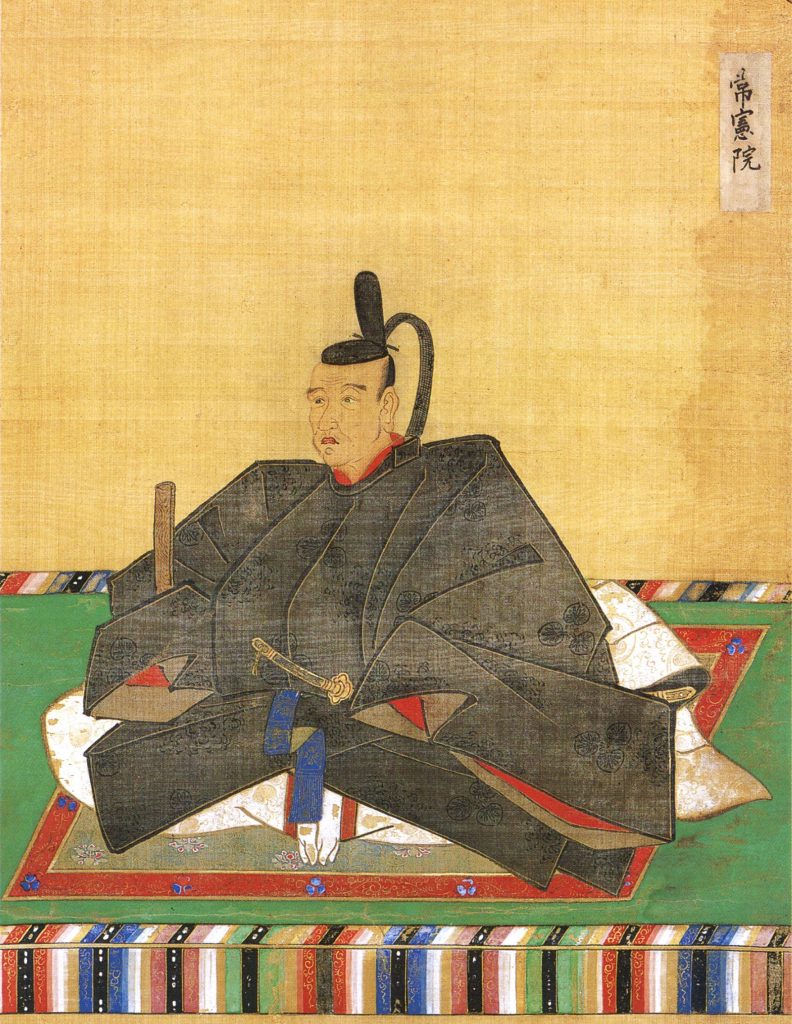
Last but not least, the abbot of Gokokuji’s visit to the Edo Castle is another fact which requires attention. The first recorded visit was done by the second abbot Kenkō for giving lectures at the Edo Castle.[35] Since Gokokuji became the praying temple for the shogunate in 1692, the frequency of visits increased rapidly into roughly once a week, for the abbot’s present was needed at various circumstances. Some of the recorded examples are as following:
Genroku 10.2.1: For lecturing on Buddhist sutras [Kaii, the third abbot of Gokokuji] visited the Edo Castle. He left on eight o’clock and has returned at [?] at night.[36]
Genroku 12.1.13: [Kaii] has visited the Sannomaru today for celebrating her [Keishō-in’s] birthday. He presented a box of Kunenbo oranges [as gift] …[37]
Genroku 14.10.25: [Kaii] visited the Honmaru for appreciating noh performance after eight o’clock, and has returned at night. He received a set of boxes made of Japanese cypress [as gift].[38]
Genroku 15.9.9: [Kaii] has left at eight o’clock on morning…for visiting the Edo Castle. After giving greeting [for the Chōyō Festival] at the Honmaru, he went for the Sannomaru, and has returned in the evening.[39]
Genroku 16.9.23: At eight o’clock this morning, the Lady of Ichii suffered from food poising… [Kaii] was ordered emergently to check on her condition. [He] followed the order and went to the Edo Castle immediately.[40]
These examples indicate that the abbot of Gokokuji was obliged to visit the Edo Castle under various circumstances. His presence was required not only on annual events such as festivals and Keishō-in’s birthday, but also on regular duties such as lecturing on Buddhist sutras and appreciating noh performance with the shogun and other important figures. In case of emergency, he was also one of the persons to be called into the Edo Castle immediately. The frequent presents of Gokokuji’s abbot in the Edo Castle indicates not only the close tie between Gokokuji and the shogunate, but also that Keishō-in and Tsunayoshi recognize the abbot as a member of their “inner community” consist of powerful figures coming from both inside and outside of the Edo Castle.
The interactions between Gokokuji and the shogunate has been consistently active throughout the reign of Tsunayoshi. The shogunate has established close tie with Gokokuji through ordering amulets and prayers, paying visit to the temple, exchanging gifts on a regular basis, and requiring the abbot’s visit to the Edo Castle for performing various of duties. In the latter half of Tsunayoshi’s reign, Gokokuji has raised into one of the most permanent temples in Edo within about two decades. Furthermore, after years of cooperation, Gokokuji’s service has seemingly become indispensable to the shogunate, and the tie between the two has also seemingly to become unbreakable. However, the second part of this paper is going to demonstration how fast things could change within only a decade after Keishō-in and Tsunayoshi’ death.
Gokokuji After Tsunayoshi’s Death
The record on the Genroku 16 (1703).10.18 indicated that Keishō-in has suffered from a stroke.[41] Her condition deteriorated gradually in the following years, and she eventually died on the Hōei 2 (1705) 6.22.[42] Even with Keishō-in’s death, there was no significant alternation in the relationship between Gokokuji and the shogunate. Kaii, the abbot of Gokokuji at the time, participated actively in Keishōin’s funeral at Zōjōji.[43] Gokokuji was ordered to build a memorial hall for Keishō-in with subsidization from the shogunate.[44] On the 25th day of the 10th month, Hōei 5 (1708), Tsunayoshi made his final pilgrimage to the Gokokuji. As always, he listened to the lecture of the abbot on Buddhist sutras, and returned to the Edo Castle in the afternoon.[45]
However, after Tsunayoshi’s death in Hōei 6 (1709), the fate of Gokokuji changed drastically. Only three months after Tsunayoshi’s death, the firewatcher (hi no ban) of Gokokuji, a position installed by the shogunate in Genroku 12, was abrogated.[46] At the end of the year, the shogunate decided to reduce the annual praying fee (nenchu kitō ryō) from eighty pieces of silver to fifty each year, whereas the amount of amulets and prayers to be presented to the shogunate were not reduced accordingly.[47] In Hōei 7 (1710), the shogunate ordained Gokokuji to dismantle the reception palace for the shogun (onari-ten), indicating that the shogun would no longer make official tours to Gokokuji regularly.[48] In Shōtoku 4 (1714), Son’yū, the fifth abbot of Gokokuji, was obliged to retire (enryo) as a punishment for “malpractice in supervising the townspeople’s houses in front of the temple’s gate, which harbored unlicensed prostitutes.”[49] It was the first time that the abbot of Gokokuji was punished by official ordinance of the shogunate.
The most significant decline for Gokokuji, however, occurred in in Kyohō 1 (1716). In the 9th month, the eighth shogun Tokugawa Yoshimune (1684‒1751) suspended Gokokuji’s presentation of amulets and prayers to the shogunate, intending to nullify its status as a praying temple.[50] However, the ordinance has met substantial resistance from Gokokuji to preserve its association with the Tokugawa house. Eventually the compromise was made that Gokokuji was allowed to continue presenting amulets to the shogunate, but only once a year, and the annual praying fee was further reduced to twenty pieces of silver.[51] This incident marks the apex, as well as the last major attempt for the shogunate to sever its relationship with Gokokuji. As a result, Gokokuji managed to preserve its marginal association with the shogunate, which continued to exist until the downfall of the Tokugawa regime in late nineteenth century.

Why did such drastic transformation in relation between Gokokuji and the shogunate occur within only a decade? The nature of their ties might be a considerable factor. As Gokokuji was founded as the Keishō-in’s temple, and as she and Tsunayoshi has mainly utilized the temple as a place for family reunion, it is relatively reasonable to argue that the ties between Gokokuji and the shogunate were, in fact, a private relationship between Keishō-in, Tsunayoshi, and Gokokuji. When the two figures passed away, and neither of their funerals were held at Gokokuji, the private association was dissolved automatically. Nonetheless, this may only explain why transformation happen, but not why it happened so swiftly. To answer the latter question, it is necessary to look into the historical context of Tsunayoshi’s reign, as well as how the transition of power affected the shogunate’s policy.
Tsunayoshi’s Reign and the Transition of Power
Tsunayoshi was known for his extraordinary enthusiasm in studying Confucian classics. Nonetheless, the majority of his policies were criticized by historians as “bad governance” (akusei) for causing poverty and social discontentment. Issues like local officials’ corruption, inflation caused by the currency reform, and the immense expenses spent on renovating temples and shrines have resulted in not only the spread of poverty among townspeople, but also in a financial crisis for the shogunate.[52]
In fact, criticism against Tsunayoshi’s rule has already been substantial during his reign. The Record of the Contemporary Reign (Gotōdai-ki, 1998) by Toda Mosui (1629‒1706), a samurai retainer living in Edo during the Genroku period, was an example. In his work, Toda criticized that Tsunayoshi “does not have the competence to rule over Heaven and Earth,” and because of his poor governance “everybody has become impoverished, [the people living in penury would start] to plan for bad and subversive things, and Heaven and Earth would become destabilized.”[53] Regarding the Ordinance of Sympathizing with Living Beings (Shōrui Awaremi no Rei), Toda argued that even though dogs in Edo were ostensibly protected by the ordinance, puppies were nowhere to be seen on streets, so they must have been killed by the townspeople covertly.[54] He criticized the ordinance for compelling people to murder animals ruthlessly, even though the goal was initially to protect living beings.[55] Although Toda has never intended to publish his work during the reign of Tsunayoshi, his rigorous criticism indicates that there has already been substantial discontent toward Tsunayoshi’s policies among the public during the reign.
For Figure 12. Gotodai-ki, 17-18th Century, please click here.
Besides commoners, powerful figures within the shogunate have also become dissatisfied with many of Tsunayoshi’s policies. Although they were not able to carry out effective reforms during the reign of Tsunayoshi, the consent about reform has already developed into certain degree of maturity. These perquisites have enabled reforms to be carried out right after the transition of power without many preparations. In fact, including the case of Gokokuji, all sorts of reforms have been carried out swiftly under the new administration. After the position of shogun has been succeeded by Tokugawa Ienobu (1662‒1712), one of his first ordinance was to abrogate the Ordinance of Sympathizing with Living Beings.[56] Eventually the reform was carried out in full scale during the reign of Tokugawa Yoshimune, including opening channels for townspeople’s voice, and raising taxes for recovering the shogunate’s financial status.[57] Nonetheless, for Gokokuji, the reform meant not only decline in financial subsidization, but also termination of its eminent tie with the Tokugawa family, which was established during the reign of Tsunayoshi.
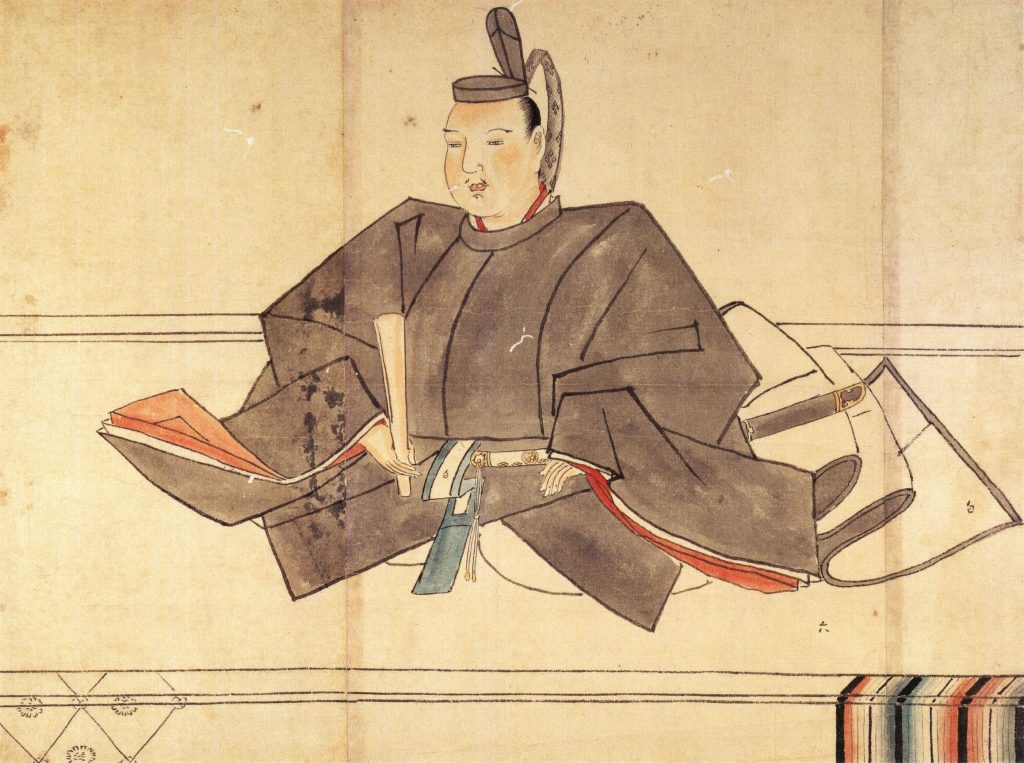
Conclusion
Throughout the reign of Tsunayoshi Gokokuji has enjoyed various privileges from its relationship with the Tokugawa shogunate, which resulted in its rapid rise into one of the most eminent temples in Edo within less than two decades. However, as the consent of reform has already taken its shape when Tsunayoshi was alive, the latter shogun Iemitsu and Yoshimune have carried out reforms swiftly after his death, in order to neutralize the negative effects caused by his policies as soon as possible. As its ties with the shogunate dissolved naturally after Keishō-in and Tsunayoshi’s death, Gokokuji has inevitably become a target of the reform, declining drastically within a decade. Although the story of Gokokuji in early Edo period might be regrettable to hear about, it was part of the shogunate’s effort to reform the old policies in order to save itself from inefficient governance and financial crisis. The more significant changes for Gokokuji would take place after Meiji, which the majority of temple’s land would be confiscated by the new government.
[1] See in Andō (2009), p. 30.
[2] See in Andō (2009), p. 31.
[3] See in Suga (1990), p. 17.
[4] See in Makino (2011), p. 89.
[5] Denzuin-shi (1919), p. 6–7. 「開山の師範と申すは…了譽聖冏禅師と號し、著述の書、凡五百余卷諸宗兼學…凡諸宗にも斯る總該萬有の師は無之侯…増上寺開山聖聰上人、頻に師の恩徳を仰ぎ…小石川に庵室を作り、著述をたすけ、弘道をすゝめらる…かゝる名徳の舊跡、今時すでにたえだえなれば、後世空しく其のあどを失はむ歟。伏して願くば、了譽上人の遺跡を再興し給ひ、聖冏庵の舊號を改め…御法名を改め永く末代に傳へ。」
[6] Denzuin-shi, p. 13.
[7] Sonehara (2008), p. 51.
[8] Gerhart (1999), p. 114.
[9] See in Gerhart, p. 116.
[10] See in Gerhart, p. 118.
[11] See in Sonehara, p. 145. The Tōshōgu built in the Edo Castle was named Momijiyama Tōshōgu.
[12] See in Sonehara, p. 145-147.
[13] See in Sonehara, p. 149-152.
[14] See in Gokokuji-shi (1988), p 1.
[15] See in Gokokuji-shi, p. 48-49.
[16] See Gokokuji-shi, p. 53, 67.
[17] Gokokuji-shi, p. 125.
[18] See Gokokuji nikki (2014), explanatory note, p. 1.
[19] Gokokuji nikki, vol.1, p. 30-31.
[20] See in Gokokuji-shi, p. 23.
[21] Gokokuji nikki, vol. 1, p. 5. 「一、姫君様(鶴姫)へ御札守御上ケ、御使僧義天、」
[22] Gokokuji nikki, vol.1, p. 68. 「一、夜被仰付候ハ、千代姫様(徳川光友室、徳川家光女)御當病平癒之御祈禱ニ、御當卦文殊法并不動法七座宛修行可仕候由、」The method of Monjū is a fortune-telling ritual performed through borrowing the power of mañjuśrī, and the method of Fudō is a healing ritual performed through borrowing the power of acalanātha.
[23] Gokokuji nikki, vol.2, p. 6. 「一、大久保加賀守様(忠朝、老中)へ、御頼之公方様(徳川綱吉)御祈祷御札被遣候事、」
[24] Gokokuji nikki, vol.2, p. 220. 「一、今朝夘刻(マヽ)日蝕ニ付、為御祈祷八字文殊之法、於五壇更ル〻復候迄座を重ね執行仕候、御祈禱畢其儘御札守御本丸奥方へ被差上候、御ふミ(文)相添、」The Five Altar五壇 refers to the altars for placing the five vidyā-rāja.
[25] Gokokuji nikki, vol.1, preliminary.
[26] Gokokuji-shi, p. 15.
[27] Gokokuji nikki, vol.1, p. 100-101. 「四月廿一日、曇天、申刻細雨、一、今日、公方様(徳川綱吉)・三之御丸様(桂昌院)、當院へ被為成候事、一、三之丸様…當寺へ被為入候者五ツ半過也…御膳被召上、夫ゟ高山御茶屋(護国寺境内)へ被為入、又方〻御遊歷被遊、畫過御そば切出候而、夫ゟ御殿へ歸御被遊候、一、公方様御成巳下刻…顯行㕝度之論題ニ而問答有之候、護持院前大僧正(隆光)・小池坊僧正(大和長谷寺、英岳)…夫ゟ論語少御講談被遊、次ニ御仕舞拜見被仰付…牧野(康重)周防守殿、黑田(直邦、小姓)豐前守殿兩人へも被仰付仕舞被致候…公方様還御八ツ時前也、三之丸様歸御七ツ時過也、」
[28] Gokoku-shi, p. 25-26.
[29] Gokokuji nikki, vol.3, p. 21. 「一、一位様へたんほ一籠 な(菜)一折、御上ケ被遊候、」
[30] Gokokuji nikki, vol.3, p. 93. 「一、 右京大夫(輝貞、側用人)殿ゟ御奉書ニ而、暑氣御尋被遊、熟瓜一籠御拜領被成候事、御請不仕、」
[31] Gokokuji nikki, vol.3, p. 102-103. 「一、一位様ゟ、御ふミ相添、なし(梨) りんこ一籠被遣侯」
[32] Gokokuji nikki, vol.3, p. 108. 「一位様へ手前之茄子一籠被指上之候、…」
[33] Gokokuji nikki, Vol.3, p. 40. 「一、獻上物、公方様江、昆布一箱、御仕舞扇一箱、御檜重一組、造花一飾、九久年母一箱…一位様へ、昆布一箱、造花一飾、御檜重一組、久年母一箱、青物一籠…拜領物、公方様ゟ、御小袖御手ミやけ(土産)三ツ、御伽羅、銀如前〻百枚、惣中へ銀五十枚、一位様ゟ、御小袖御手ミやけ七ツ、眞綿五十把、黄金如前〻五枚、惣中へ金万疋、…」
[34] See in Gokokuji-shi, p. 1-2.
[35] See in Gokokuji-shi, p. 381.
[36] Gokokuji nikki, Vol.1, p. 10. 「一、御講尺(釋)ニて登城被成、五ツ時ゟ御出、夜入□ツ時ニ御歸被□□」
[37] Gokokuji nikki, Vol.1, p. 77. 「一、今日、如例御誕生日ニて御座候ニ付、三之丸へ御上り被遊候事、久年母一箱御上ケ被遊候、…」
[38]Gokokuji nikki, Vol.2, p. 86. 「一、御本丸ニ而御能座候に付、五ツ過御登城被遊候事、夜ニ入御歸被成候、御□(檜)重一組拜領之事、」
[39] Gokokuji nikki, Vol.2, p. 253. 「一、朝五ツ前御出駕、…夫ゟ御登城、御本丸御礼過、三御丸へ御上り被成候而、夕方御歸被成候事、」
[40] Gokokuji nikki, Vol.3, p. 133. 「一、今朝五ツ時、一位様少御食傷之御様躰之由、…押付あなたゟ御ふミニ而、御様躰被仰越候、依之、俄ニ御登城被遊候、」
[41] See in Gokokuji nikki, Vol.3, p. 149.
[42] See in Gokokuji nikki, Vol.4, p. 97.
[43] See in Gokokuji-shi, p. 55.
[44] Gokokuji-shi, p. 57. 「…また金三百両が護国寺内に建てられる桂昌院位牌堂建立料として下られた。」
[45] See in Gokokuji-shi, p. 65.
[46] See in Gokokuji-shi, p. 387. And Gokokuji nikki, Vol.1, 96.
[47] See in Gokokuji-shi, p. 73.
[48] See in Gokokuji-shi, p. 73.
[49] Gokokuji-shi, p. 74. 「正徳四年(一七一四)…、尊祐は出仕をとどめられる『遠慮』を申しわられた。『門前町屋にひそかに私娼が置かれているのを見逃していた。これは住職として監督不行届である』というおがその理由であった。(『徳川実記』)」
[50] See in Gokokuji-shi, p. 77.
[51] See in Gokokuji-shi, p. 77.
[52] Takeuchi (2003), p. 182.
[53] Tsukamoto (1998), p. 227-228. 「『天下を治させ給ふべき御器量なし、此君天下のあるじとならせ給はば諸人困窮仕、惡逆の御事つもり、天下騒動のことあるべし。』」
[54] See in Tsukamoto, p. 231.
[55] See in Tsukamoto, p. 231.
[56] See in Takeuchi, p. 16.
[57] See in Takeuchi, p. 184.
References
Gerhart, Karen M. The Eyes of Power: Art and Early Tokugawa Authority. University of Hawai’i Press, 1999.
Nozawa Shungei 野澤俊冏. Denzūin-shi 伝通院誌. Denzūin, 1919.
Edited by Sakamoto Masahito 坂本正仁. Gokokuji nikki 護国寺日記. 5 vols. Yagi Shoten, 2014.
Andō Yūichiro 安藤優一郎. Ōedo odera hanjōki 江戸お寺繁昌記. 平凡社, 2009.
Sonehara Satoshi 曽根原理. Shingun Iyeasu no tanjō: Tōshōgu to Gungen-sama 神君家康の誕生: 東照宮と権現様. 吉川弘文館, 2008.
Gokokuji-shi 護国寺史. Edited by Gokokuji-shi Hensan Iinkai 護国寺史編纂委員会. 護国寺, 1988.
Tokugawa bakufu jiten 徳川幕府辞典. Edited by Takeuchi Makoto 竹内誠. 東京堂、2003.
Tsukamoto Makabu 塚本学. Tokugawa Tsunayoshi 徳川綱吉. 吉川弘文館、1998.
Illustrations
Artist unknown, Portrait of Keishōin, circa 1804, Hase-dera temple, Nara, Japan in Wikipedia, https://commons.wikimedia.org/wiki/File:Keish%C5%8Din.jpg. Accessed July 23, 2021.
Artist unknown, Portrait of Tokugawa Tsunayoshi, 18th Century, Hōryū-ji, Nara, Japan in Wikipedia, https://commons.wikimedia.org/wiki/File:Tokugawa_Tsunayoshi_H%C5%8Dry%C5%AB-ji.jpg. Accessed July 23, 2021.
Unkei6hokusai4, sandō kara mita Ueno Tōshōgu honten to kara-mon参道から見た上野東照宮本殿と唐門, February 18, 2014 in Wikipedia, https://commons.wikimedia.org/wiki/File:Ueno_T%C5%8Dsh%C5%8D-g%C5%AB_DSC02758.JPG. Accessed July 23, 2021.
Collection of the Ueda City Library上田市立上田図書館蔵, gotōdai-ki 御当代記, 17-18th Century. https://www.echol.gr.jp/digilib/gotodaiki/html04/gtd172.html. Accessed July 23, 2021.
Unknown (A painter of the Kanō school), Portrait of Tokugawa Ienobu, 18th Century, Tokugawa Memorial Foundation in Wikipedia, https://commons.wikimedia.org/wiki/File:Tokugawa_Ienobu.jpg. Accessed July 23, 2021.
Kanō Tadanobu, Portrait of Tokugawa Yoshimune, 20th Century, Tokugawa Memorial Foundation in Wikipedia, https://commons.wikimedia.org/wiki/File:Tokugawa_Yoshimune.jpg. Accessed July 23, 2021.
*Illustrations without reference are private pictures taken by the author.
